#apparently it's much better for them to never change the substrate so it can develop a beneficial bacteria ecosystem
Explore tagged Tumblr posts
Text
My favourite things about snails is pets is that you actively aren't supposed to clean them out. It's amazing. Perfect depression pet.
#by clean out I mean change out the substrate#I just wipe down the walls of the tank occasionally#apparently it's much better for them to never change the substrate so it can develop a beneficial bacteria ecosystem#draco speaks#idk if it's just me but they seem to smell way less than other caged pets I've had despite that#I do not miss the smell of feeder crickets
1 note
·
View note
Text
Folk understandings of sexuality my experience of turning bi awkwardly accords with
So, this spring, as the apparent culmination of some personality changes I had noticed setting in after I heimliched myself the previous year crossed with what seemed to be an increasingly irregular bipolar cycle, I was mentally unstable for a few weeks and when I rebalanced afterwards it was with a slightly different set of basic drives – anxiety and inhibition were appreciably reduced, and though long straight I was now bisexual.
This was, basically, ridiculous, I had written off those "your sexuality may change over the course of life" lines as excuses for the shy to come out after long covering, but if it was happening I might at least harvest the insight of having seen things from different angles. And on reflection, a lot of it fits with a kind of folk mechanics of sexuality I had maybe been dismissing as too vulgar, but well let's think about that
Bisexuality as "Anything That Walks" low standards
I can't help but notice that the same personality change strongly limited my anxiety and muted my inhibition, making me more outgoing and chatty and simultaneously expanding the boundaries of women I'd consider as sexual/romantic partners, both body- and -personality-wise. Being open to more sex partners is, in fact, related to being open to more sex partners. Probably related to how everyone's bisexual on enough cocaine (the definition of "enough" cocaine)
Autogynephilia/MTF as extreme heterosexuality
I identified as female for part of adolescence. That's long stopped, I'm a boy, but part of what I'm struck by so much in coming to sexually appreciate men and male sexuality is that includes my own, which even aside from direct coming-to-orgasm matters just makes my maleness so much more satisfying to inhabit. And I do wonder how much womanhood being the only thing to appeal to me accounted for wanting to see myself in those terms as a way to recognize and enjoy myself as valid.
Homosexual desire as narcissistic
I guess this is the flip side of that "I can now appreciate things in my male self" thing above. One of the ways I've been putting it is I don't have to jerk off about anything anymore, because "a man's hand jacking me to orgasm", "a hard dick in my hand" and "the idea of a guy masturbating" are all hot to me in their own right.
And being into my own body means it's more rewarding to develop it so I can admire it. For one this makes Ancient Greece suddenly click much harder, for two gay gym culture, and I can see how that gets ridiculous if all your social circle is hot boys who do that, see each other, and then update their sense of normal accordingly. Hopefully the connection with women will keep me from such extreme vicious circles as those guys who were so into Tom of Finland they killed a few of themselves injecting fillers into their balls.
Bisexuals as untrustworthy
For one, shortly into the change I thought about those old "religious right" patriarchs fulminating against homosexuality who turned out to have male lovers, and we'd laugh about repressed homosexuality. But "upright-preaching man has side piece" is dog bites man, and "married man who valorizes male-female coupling as the foundation of society enjoys sex with men" honestly makes more sense as bisexual.
And maybe not so dramatic, but like, I spent several decades expecting my personal and social life to be tied up with relationships with women, with an upbringing that had stronger expectations (and a self-understanding this was a relaxation of stronger expectations still). I'm honestly fine with that – for someone who might be counted as part of some queer coalition I am quite comfortable with quite a bit of heteronormativity, and honestly feel more at home there than in many queerer scenes.
For two, going back to the first point above, this came as part of a package deal of becoming less inhibited and more social, which included talking my way into bed with girls when I didn't even realize that's what was going on, more instinctively operating to an "emotional" register of talking where the content is a meaningless substrate for evoking, reflecting, and amplifying sensibilities to make a connection, with a "gift of the gab" that doesn't know where it's going until it comes out of my mouth
And I haven't been in a relationship since this happened, and I think I've got a bit better handle on it now using the habits of mind I developed over several more neurotic decades, but I'm just saying there may be a type of person that's more likely to unthinkingly seduce random people they come across independent of any logical calculation such as "is this in conflict with my exclusive relationship with someone else" and bisexuality may be an indicator.
Bisexuality/pansexuality distinction
I'm told this is a big Discourse but it's all worthless so I've never bothered to see what it's about but I'll guess, knowing that if I misrepresent them they don't matter. When I was straight I was prepared to politely aver that no thanks, I had a cis fetish. In that trans women did not particularly do it for me
(I mean 4chan-type "traps" were defined by appealing to straight male sensibilities, but that wasn't particularly my thing and the things that were featured chicks without dicks)
and maybe trans men but I doubt I'd be appreciating them as men. Which given the ubiquity of the "fuck my pussy like a girl" thing might even work I suppose (which you can account for as a fujoshi-on-T fantasy without bringing gender into it, on the other "pretend I'm a girl and give me your str8 load" is a pretty classic gay guy pitch)…
By now, I mean I'm sure someone's constructed a gender identity that definitionally doesn't appeal to me, or at least they will now that I've tempted them, but it's not so much a thing. I do think of myself as "bi" over "pan" part simply because I established my sense of what sexuality is in the 90s. But part it's I suspect I'm not valuing the luvvies as they're identifying but as some varying admixtures of boy and girl which work for me in any proportion. It's just not terribly important to me what someone really is anymore because I don't have a major personality feature keying off that
Heterosexuality is really like that
…but I am intimately aware from memory that many people do. Originally I thought of this as "bisexuality is really like that" like, all of a sudden men were not just eligible for sexual ideation but heartwarmingly imagining relationships with. But to flip it around, yeah, until then it was only women that worked with and men were just blank.
Like when I was younger I tried to bihack myself, and I think dismissed any sort of distaste with the idea, and thought I was at least Kinsey 2 (I wasn't) and even tried hooking up with some guy. I felt his tongue and I'm sure the guy knew his way around a dick but there was no spark to it, other way around it wasn't degrading but just an unrewarding bother, like giving someone a massage with your mouth while they choke you. So I realized that the fact I never fantasized about men was a good sign I was straight.
So, uh, cut straights the same slack as everyone else, it's not like they have bad ideas they're just like that. Gays and lesbians too. including that the boundaries of their attraction won't necessarily be where you want to carve gender up for your own reasons. Not bad ideas, they're just like that.
23 notes
·
View notes
Photo
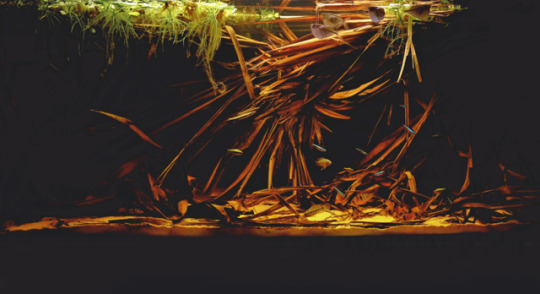
YOUR TANKS: TAI STREITMAN
Source: practicalfishkeeping.co.uk
An aquarist who travels the world and builds tanks based on where he’s been is inspiring. What’s even better is when he shares those tanks with the rest of us...
WORDS: TAI STREITMAN. PHOTOGRAPHY: GEORGE FARMER
Looking around at the hobby today, I feel it’s fair to say that for many fishkeepers, the days of plain aquarium gravel, a few plastic plants and a novelty treasure chest air-stone have been left behind. High tech aquascapes, biotopes and complex reef systems have all entered the hobby and changed our perspectives on what is feasible, what is available and what is ethical.
There are those who will never relinquish plastic plants, shipwrecks and a diverse community, and that’s fine — each to their own. As long as fish are healthy and quality of life is maintained, people can put whatever they like in their tanks.
My own feeling is that for a little effort, we can create displays that not only prioritise the wellbeing of our fish, but also look beautiful and natural. Looking online or at some of the incredible aquascapes that appear in this magazine can be daunting, but a bit of research and patience can provide even the beginner with an engaging and successful set-up.
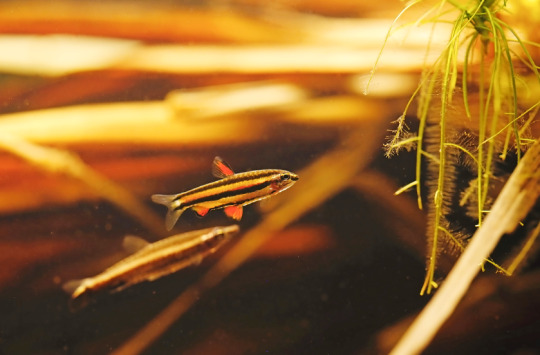
Nannostomus marginatus.
Forest shadows
I’m a huge fan of blackwater set-ups. If it looks like tea, I’m in. These set-ups aren’t hard to create, although maintaining water quality and stability are important. Using lots of wood and leaf litter produces tannins that stain the water and lower the pH. Also, believe it or not, they’ll bring out the colours of many species more spectacularly than crystal clear water.
Many of our popular characins, dwarf cichlids, rasbora and gourami species will all thrive in blackwater set-ups that mimic their natural environments. I was lucky enough to explore blackwater streams in Colombia and Peru and they have inspired me to create a small blackwater community with species found in the Amazon basin.
I have used a 90cm/36in, 100 l/22 gal tank and Catappa leaves (easily bought online) and a stash of dried finger palm fronds that actually come from the gorilla enclosure at London Zoo!
You can just as easily use beech or oak leaves and it’s worth collecting a few bags in the autumn and storing them in a dry space for use as and when you need them. Amazon frogbit, Limnobium laevigatum, and Salvinia natans provide cover for the fish and with those aerial roots they suck up spare nutrients.
I wanted to have activity at all levels and my choice of fish reflects this. At the top, Giant hatchetfish, Gasteropelecus sternicla, and Hockey stick pencilfish, Nannostomus eques, cruise through the floating plants. Slightly lower down, a troupe of Dwarf pencilfish, Nannostomus marginatus, flit through the palm fronds while Green neons, Paracheirodon simulans, emerge from the shadows to show off their brilliant iridescence before diving away again. A few juvenile Gold tetras, Hemigrammus rodwayi, add contrast to the Green neons in colour and body shape.
At lower levels, charismatic Apistogramma viejita and Rams, Mikrogeophagus ramirezi, scuffle and argue over small territories and favourite display spots. Keeping several females to each male reduces tension but providing plenty of cover is the best way of ensuring that no one fish gets hounded by an opponent or over-amorous male.
Finally, on the bottom the classic Panda corys, Corydoras panda, shuffle and nuzzle their way through the sand and leaf littler, hunting for morsels and providing endless movement.
This was a very simple set-up; two 24W T5 bulbs, a 150W heater, dried leaves, play sand and floating plants was no great investment. The only thing you should not cut corners on is filtration and this tank uses an Aquamanta 300 EFX filter with a flow rate of 1100 lph, although this is turned down to mimic the flow of the natural habitat.
This is one of my favourite set-ups, where the colours and characters of the fish draw you in and the simplicity of the set-up makes running the tank very straightforward.
Blackwater tank factfile
Fish:
Gasteropelecus sternicla
Nannostomus eques
Nannostomus marginatus
Paracheirodon simulans
Hemigrammus rodwayi
Apistogramma viejita
Mikrogeophagus ramirezi
Corydoras panda
Plants:
Limnobium laevigatum
Salvinia natans
Water parameters:
Temperature: 26°C/79°F.
pH: 6.5.
Hardness: 18–215 ppm.
Equipment: 2 x 24W T5 bulbs (running six hours a day). 150W heater. Aquamanta EFX 300 filter.
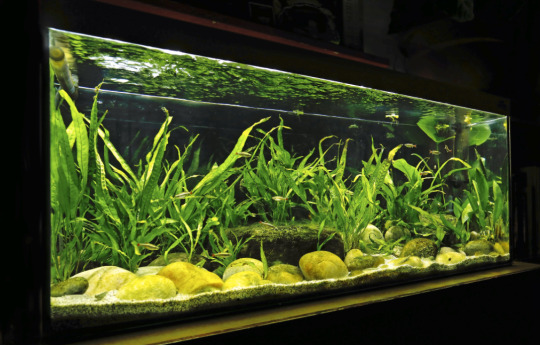
This tank was set up for Stiphodon gobies after observing them in their natural habitat in the Philippines.
Cool rapids
Aquarium species and their needs are nothing if not diverse and staying with the theme of simple, easy set-ups catering to the needs of engaging and charismatic species, I have also set up a hillstream tank for Stiphodon atropurpureus. I got to see Stiphodon gobies in the wild in the Philippines and vowed to keep them at home. These little gems are often seen in shops, slowly starving to death in tanks devoid of the auchwuchs they need to graze on, with little flow and kept much warmer than their natural waters. As these fish are always wild caught, providing them with a close replica of their habitat is vital for success. Cool (20–24°C/68–75°F) oxygen rich water, excellent filtration and plenty of algae and hidey holes will see these little characters thrive. Unlike many gobies, my S. atropurpureus are not aggressively territorial. There may be the odd spat, but again, providing several females for each male and ensuring that each male has at least one big rock he can perch on will generate harmony. Watching them graze over boulders in a line abreast is very satisfying!
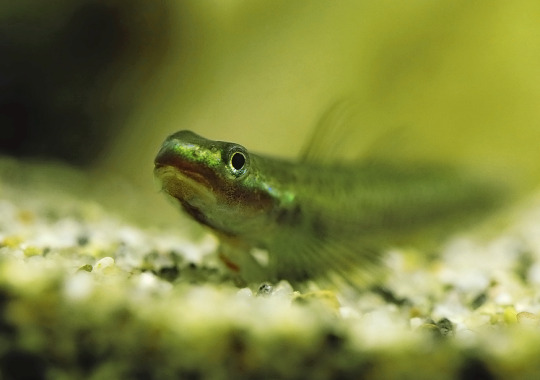
Stiphodon gobies prefer the cooler, oxygenated water this set-up provides.
Although plants are not a feature of their natural habitat, I have included Java fern, Microsorum pteropus, and Anubias, both of which will tolerate the flow and cooler temperatures, so as to add colour and cover. Algae gathers on the leaves of these slow-growing species and the gobies will tear chunks off and zip over the plants, happily grazing. The main rocks in this tank were allowed to soak in a tub outside for weeks to build up enough algae to support the gobies when they were added and this will quickly spread to newly added pebbles.
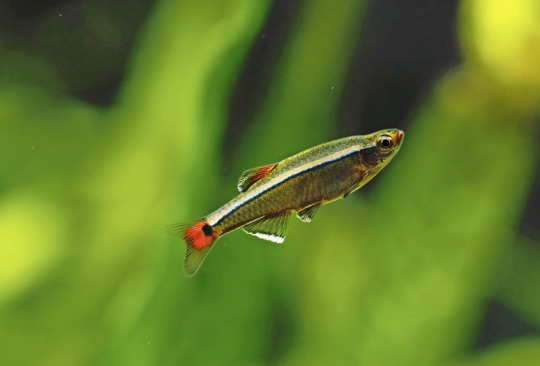
White Clouds add colour and movement at midwater level.
For dither fish I have added White Cloud Mountain minnows, Tanichthys albonubes, a truly underrated little fish which, when kept in cool water with plenty of flow and oxygen, will reward you with gleaming red and gold colours, and stunning displays by the males.
While Stiphodon aren’t the cheapest of fish, the rest of this set-up can be created affordably. An Aquamanta EFX 400 filter provides flow and a high turnover in this 100 l/22 gal tank. No heater is used but to produce plenty of algae, I’ve added cool-running TMC Grobeams, (these could be replaced with simple T5 bulbs). A fine substrate that isn’t light enough to be moved about by the flow allows the gobies to dig. I’ve opted for standard, fine gravel.
Hillstream tank
Fish: Stiphodon atropurpureus Tanichthys albonubes
Plants: Anubias nana Anubias congensis Anubias hastifolia Microsorum pteropus
Water parameters: Temperature: 22°C/72°F. pH: 7.0. Hardness: 18–215 ppm.
Equipment: 2 x TMC Grobeam LEDs (ten hours a day). Aquamanta EFX 400 filter.
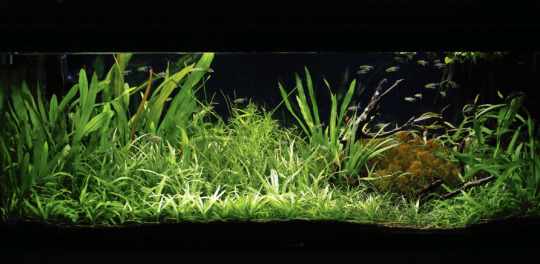
This jungly set-up was the result of a trip to wetlands in Brazil.
Going green
As an aquatic plant enthusiast, I have to have at least one planted aquarium and so my main tank, a 240 l/ 53 gal set-up, is stuffed with greens. I combined plants and species from several habitats from the Pantanal wetlands of Brazil to produce a busy but not overbearing display with subtle fish colours, plenty of movement and some cryptic yet charismatic species.
I enjoy creating layouts with different plant heights and textures and then letting them run riot. A jungly tank, where you have to work to spot some of its inhabitants will always hold more interest for me than a display where everything is on show, straight away.
Again, this is not a particularly difficult display. CO2 injection, a daily and weekly fertiliser regime for the plants, twice-weekly water changes and solid filtration (in the form of a Fluval FX6) does not entail too much effort, but the rewards are considerable.
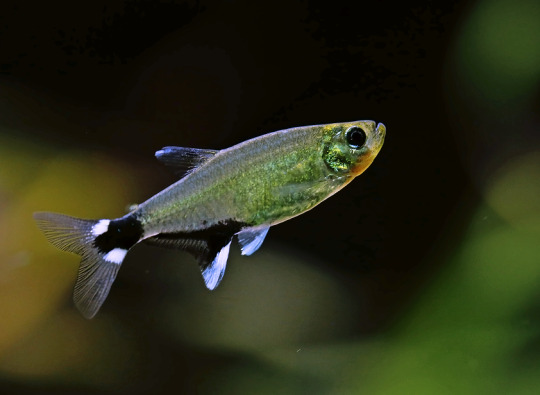
Dawn tetra, Aphyocharax nattereri.
I believe in trying species that are either considered common or dull, and working to get the best out of them by creating an ideal environment. In this case, I have chosen the Dawn tetra, Aphyocharax nattereri. Famed for being a fin nipper, this behaviour (as in many species) does not become apparent when they are kept in sufficient numbers. They will spend their time chasing each other, with no one fish receiving too much aggression, and race about the tank in their battles to establish hierarchy. You will likely never notice this in shops, but the males develop a soft red on the bellies and anal fin and when well kept, they develop a lovely green gold colour on the body.
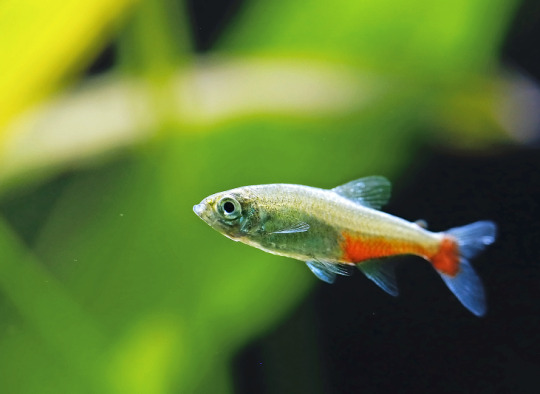
Aphyocharax rathbuni.
A group of Serpae tetra, Hyphessobrycon eques, provides riotous colour to contrast with the subtle tones of the other species and the green backdrop. Rathbun tetras, Aphyocharax rathbuni, dart between the tall leaves and hover like aquatic hummingbirds, eyeing up the situation before zooming to another part of the tank. A gang of Red-breasted acara, Laetacara dorsigera, stalk the long grass, their purple flanks gleaming through the blades of Echinodorus.
Several shy Sheepshead acara, Laetacara curviceps, watch from the shadows and then emerge slowly into the light, their shimmering blue scales, erratic movements and suspicious investigation of everything making me smile. Isn’t that what it is all about at the end of the day? Making your fish happy, so they make you happy?

Laetacara curviceps.
Planted tank
Fish: Aphyocharax nattereri Hyphessobrycon eques Aphyocharax rathbuni Laetacara dorsigera Laetacara curviceps
Plants: Echinodorus uruguayensis Echinodorus tenellus Helanthium bolivianum ‘Latifolius’ Eleocharis gigantea Heteranthera zosterifolia Myriophyllum tuberculatum Persicaria sp. ’Sao Paulo’
Water parameters: Temperature: 23°C/73°F. pH: 6.5. Hardness: 18–215 ppm.
Equipment: 2 x 39W T5 bulbs (running eight hours a day) 250W heater Fluval FX6 filter CO2 solenoid and gauge with 8kg bottle (two bubbles per second).
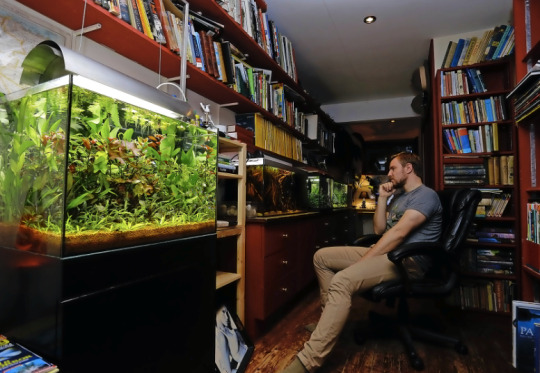
Tai at home with his tanks, many of which have been inspired by his trips around the world.
#aquarium#freshwater#freshwater aquarium#aquascape#nature aquarium#planted aquarium#planted tank#biotope
6 notes
·
View notes